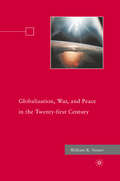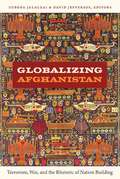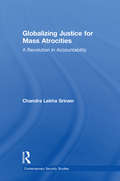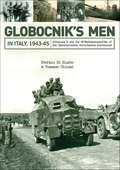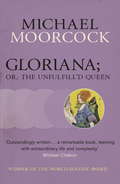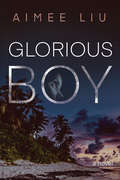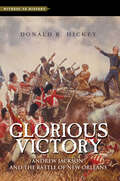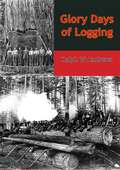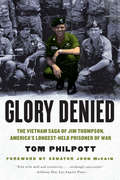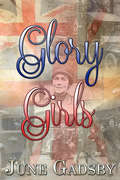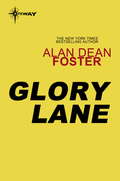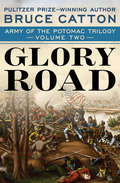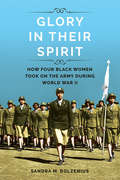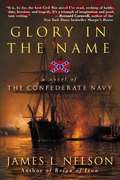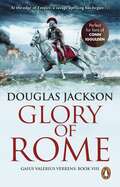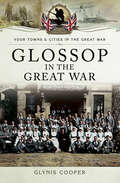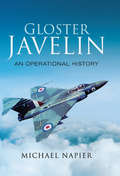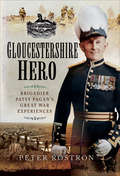- Table View
- List View
Globalization, War, and Peace in the Twenty-First Century
by William R. NesterThis book explores humanity's most persistent and tragic problem by answering some crucial questions including: How is military power created and asserted? What are weapons of mass destruction and what is the likelihood of them being used? What are the source, methods, and results of terrorism and counterterrorism?
Globalizing Afghanistan: Terrorism, War, and the Rhetoric of Nation Building
by Zubeda Jalalzai David JefferessGlobalizing Afghanistan offers a kaleidoscopic view of Afghanistan and the global networks of power, influence, and representation in which it is immersed. The military and nation-building interventions initiated by the United States in reaction to the events of September 11, 2001, are the background and motivation for this collection, but they are not the immediate subject of the essays. Seeking to understand the events of the past decade in a broad frame, the contributors draw on cultural and postcolonial approaches to provide new insights into this ongoing conflict. They focus on matters such as the implications of Afghanistan's lucrative opium trade, the links between the contemporary Taliban movement and major events in the Islamic world and Central Asia since the early twentieth century, and interactions between transnational feminist organizations and the Afghan women's movement. Several contributors address questions of representation. One looks at portrayals of Afghan women by the U. S. government and Western media and feminists. Another explores the surprisingly prominent role of Iranian filmmaking in the production of a global cinematic discourse about Afghanistan. A Pakistani journalist describes how coverage of Afghanistan by reporters working from Pakistan's Khyber-Pakhtoonkhwa (formerly the North West Frontier Province) has changed over the past decade. This rich panoply of perspectives on Afghanistan concludes with a reflection on how academics might produce meaningful alternative viewpoints on the exercise of American power abroad. Contributors. Gwen Bergner, Maliha Chishti, Cheshmak Farhoumand-Sims, Nigel C. Gibson, Zubeda Jalalzai, David Jefferess, Altaf Ullah Khan, Kamran Rastegar, Rodney J. Steward, Imre Szeman
Globalizing Justice for Mass Atrocities: A Revolution in Accountability (Contemporary Security Studies)
by Chandra Lekha SriramThis major new study examines the developing practice of universal jurisdiction, as well as the broader phenomenon of "globalizing" justice, and its ramifications. With a detailed overview of the contemporary practice of universal jurisdiction, it discerns three trends at work: pure universal jurisdiction, universal jurisdiction "plus", and non-use. It also argues that these disparities in practice should raise serious concerns as to the legitimacy and perceived legitimacy of such globalized justice. It then turns to a further consideration, that of globalized justice, precisely because it takes place far from the locus of the crime, and is therefore "externalized" and may fail to achieve many of its putative goals. In addition, this is a key assessment of civil accountability, through the use of the Alien Tort Claims Act in the United States. It details how the use of civil penalties may offer new avenues for redress, particularly with relation to group accountability, whether that of armed groups or of corporations. However, it balances this approach to accountability with recognition of certain flaws within externalized criminal accountability. This study also focuses on mixed tribunals, or other methods of internationalized justice as viable alternatives, which may avoid some of the problems with external justice, but are themselves far from perfect. Mixed or hybrid tribunals in East Timor and Sierra Leone represent different models of hybrid justice and provide the reader with excellent examples of these new forms of justice in action. This book will be of great interest to all students and scholars of human rights international law and political science.
Globocnik's Men in Italy, 1943–45: Abteilung R and the SS-Wachmannschaften of the Operationszone Adriatisches Küstenland
by Stefano Di Giusto Tommaso ChiussiThe history and activities of the notorious Nazi unit Abteilung R in Italy
Gloriana; or, The Unfulfill'd Queen: Or, The Unfulfill'd Queen
by Michael MoorcockGloriana rules an Albion whose empire embraces America and most of Asia. A new Golden Age of peace, enlightenment and prosperity has dawned. Gloriana is Albion and Albion is Gloriana; if one falls, so too will the other. And Gloriana is oppressed by the burden this places upon her - and by the fact that she remains incapable of orgasm. The maintenance of the delicate balance that keeps Albion and Gloriana thriving depends on Montfallcon, Gloriana's Chancellor, and on his network of spies and assassins - in particular on Quire, cold hearted seducer of virtue and murderer of innocence. When Quire falls out with Montfallcon, he forms an alliance with his greatest enemy and conceives a plan to ruin Gloriana, destroy Albion, the empire and the Golden Age itself. But even the utterly ruthless Quire does not fully understand what he has set in motion when he persuades the Queen to fall in love with him... Moorcock's masterly evocation of Gloriana's strange and secretive palace and of a vibrant London make this one of his most powerful and memorable novels.
Glorious Boy: A Novel
by Aimee E. Liu“An absolutely gorgeous historical novel . . . set against the backdrop of a tribe in the Andamans struggling with British rule . . . Just magnificent.” —Caroline Leavitt, New York Times bestselling author of Pictures of YouOne of Booklist’s Top Ten Historical Fiction Books of 2020Glorious Boy is a tale of war and devotion, longing and loss, and the power of love to prevail. Set in India’s remote Andaman Islands before and during WWII, the story revolves around a mysteriously mute four-year-old who vanishes on the eve of the Japanese occupation. Little Ty’s parents, Shep and Claire, will go to any lengths to rescue him, but neither is prepared for the brutal and soul-changing odyssey that awaits them.“A riveting amalgam of history, family epic, anticolonial/antiwar treatise, cultural crossroads, and more . . . a fascinating, irresistible marvel.” —Library Journal (starred review)“The most memorable and original novel I’ve read in ages . . . evokes every side in a multi-cultural conversation with sympathy and rare understanding.” —Pico Iyer, author of Autumn LightShortlisted for the Staunch Book PrizeNew York Post’s Best Books of the WeekGood Housekeeping’s 20 Best Books of 2020Parade’s 30 Best Beach Reads of 2020
Glorious Victory: Andrew Jackson and the Battle of New Orleans (Witness to History)
by Donald R. HickeyThe story of the battle that saved New Orleans, made Andrew Jackson a hero for the ages, and shaped the American public memory of the war.Whether or not the United States "won" the war of 1812, two engagements that occurred toward the end of the conflict had an enormous influence on the development of American identity: the successful defenses of the cities of Baltimore and New Orleans. Both engagements bolstered national confidence and spoke to the élan of citizen soldiers and their militia officers. The Battle of New Orleans—perhaps because it punctuated the war, lent itself to frontier mythology, and involved the larger-than-life figure of Andrew Jackson—became especially important in popular memory. In Glorious Victory, leading War of 1812 scholar Donald R. Hickey recounts the New Orleans campaign and Jackson’s key role in the battle.Drawing on a lifetime of research, Hickey tells the story of America’s "forgotten conflict." He explains why the fragile young republic chose to challenge Great Britain, then a global power with a formidable navy. He also recounts the early campaigns of the war—William Hull’s ignominious surrender at Detroit in 1812; Oliver H. Perry’s remarkable victory on Lake Erie; and the demoralizing British raids in the Chesapeake that culminated in the burning of Washington. Tracing Jackson’s emergence as a leader in Tennessee and his extraordinary success as a military commander in the field, Hickey finds in Jackson a bundle of contradictions: an enemy of privilege who belonged to Tennessee’s ruling elite, a slaveholder who welcomed free blacks into his army, an Indian-hater who adopted a native orphan, and a general who lectured his superiors and sometimes ignored their orders while simultaneously demanding unquestioning obedience from his men. Aimed at students and the general public, Glorious Victory will reward readers with a clear understanding of Andrew Jackson’s role in the War of 1812 and his iconic place in the postwar era.
Glory
by Rachel Billington'I wonder who chose the word 'glory',' murmured Arthur. 'You mean there's nothing very glorious about war.' The Major smiled. 'People expect words like glory. I do myself.' 'Oh, I'm not against it. There were glorious deeds performed.' Glory is the story of the men and women of Gallipoli and the tragic events of 1915. Of the lives lost, the hearts broken, the decisions cast, the errors made and of the dark reality of the heroic dream. It is the story of three people, changed forever, as the echoes of war ring loud through the years.
Glory Days of Logging
by Ralph W Andrews"Glory Days of Logging" by Ralph W. Andrews is a fascinating visual and historical journey into the heyday of the logging industry in the Pacific Northwest. First published in 1956, this book captures the spirit and grit of the loggers and lumberjacks who played a crucial role in shaping the American frontier.Andrews' narrative is rich with anecdotes and detailed accounts of the logging operations, from the felling of giant trees to the transportation of massive logs using steam donkeys, locomotives, and river drives. He delves into the daily lives of the loggers, exploring their camaraderie, hardships, and the dangerous, often heroic, nature of their work. The book also highlights the technological advancements and innovations that revolutionized the industry.The heart of "Glory Days of Logging" lies in its striking photographs. Andrews' carefully curated images provide a vivid visual record of the era, showcasing towering timber, sprawling logging camps, and the powerful machines that made large-scale logging possible. These photographs, combined with Andrews' informative captions and engaging prose, offer a comprehensive and immersive experience."Glory Days of Logging" is more than just a historical account; it is a tribute to the resilience and ingenuity of the logging communities. Andrews' work stands as an essential resource for anyone interested in the history of American industry, the development of the Pacific Northwest, or the enduring legacy of the logging profession.Whether you are a history buff, a photography enthusiast, or someone with a general interest in America's industrial past, "Glory Days of Logging" offers a captivating and informative read that brings a bygone era to life with authenticity and respect.
Glory Denied: The Vietnam Saga of Jim Thompson, America's Longest-Held Prisoner of War
by John Mccain Tom PhilpottNow hailed as a classic, one of the most unforgettable and heartbreaking books ever written about the Vietnam War. Glory Denied--the harrowing story of America's longest-held POW, the wrenching agonies faced by his family, and the larger story of a nation divided--returns to Norton a decade after its much-heralded publication. Excerpted in The New Yorker and later made into an opera, it is the heroic story of Floyd "Jim" Thompson, captured in March 1964, who became the longest-held prisoner of war in American history. Tom Philpott juxtaposes Thompson's capture, torture, and multiple escape attempts with the trials of his young wife, Alyce, who, feeling trapped, made choices that forever tied her fate to the war she despised. "One of the most honest books ever written about Vietnam" (Oliver Stone), Glory Denied demands that we rethink the definition of a true American hero.
Glory Girls
by June GadsbyMary, Anne, Iris and tough little Effie form a formidable group when, in 1939, they join the FANYs, or more precisely the First Aid Nursing Yeomanry, euphemistically calling themselves 'The Glory Girls'. However, the glory they dreamed of is short-lived as their unit moves from the London blitz to occupied France. Forbidden love, betrayal and tragedy stalk them and as their personal courage is tried - and sometimes found lacking - survival seems to depend largely on luck. This is especially so for Mary. As a Special Operations Executive, and with very little training, she is sent behind enemy lines in a desperate attempt to save the lives of men in a safe house under Nazi threat. And now her only contact has been murdered by the Gestapo...
Glory Lane
by Alan Dean FosterIt was a quiet night in Albuquerque, New Mexico.But then they mostly are.Seeth, token punk for the territory, was bored, bored, bored. Which was why he went ten pin bowling. Not for the bowling, you understand - it was Ladies' League Night - but to spread a little outrage among the upright, mostly overweight citizenry.And so it was he came upon the alien, playing lane 36, saved him from arrest by the pseudo-cops from outer space, found himself in a stolen van, along with Kerwin the nerd and Miranda the born-to-shop, Miss Teen America lookalike, driven by a green-skinned, tentacled shape changer and about to be space chased clean out of the galaxy...
Glory Main
by Henry V. O'NeilWe are closer to the Sims than we think ...For decades, mankind has been locked in a war with an alien enemy that resembles the human race so closely they are known as the Sims. Both sides battle for control of habitable planets across the galaxies--often at any cost.Lieutenant Jander Mortas is fresh out of officer training and new to the war zone but eager to prove himself. There's just one problem: disaster strikes while he's traveling to his first assignment. He wakes to find himself marooned on a planet that appears deserted, with the only other survivors: a psychoanalyst, a conscientious objector, and a bitter veteran of a brutal slave-scout detachment. As the group struggles to reach safety on a nearby base, Glory Main, they discover a Sim colony--which could mean their salvation, or their demise.Thrown together, they must fight the harsh elements, an ever-present enemy, and possibly each other.
Glory Road: The Bloody Route From Fredericksburg To Gettysburg (Army of the Potomac Trilogy #2)
by Bruce CattonThe riveting saga of a nation at war with itself--from the Union Army's disaster at Fredericksburg to its costly triumph at Gettysburg--by Pulitzer Prize-winning Civil War chronicler Bruce Catton In the second book of the Army of the Potomac Trilogy, Bruce Catton--one of America's most honored Civil War historians--once again brings the great battles and the men who fought them to breathtaking life. As the War Between the States moved through its second bloody year, General Ambrose Burnside was selected by President Lincoln to replace the ineffectual George "Little Mac" McClellan as commander of the Union Army. But the hope that greeted Burnside's ascension was quickly dashed in December 1862 in the wake of his devastating defeat at Fredericksburg. Following Burnside's exit, a mediocre new commander, Joseph "Fighting Joe" Hooker, turned a sure victory into tragedy at Chancellorsville, continuing the Union's woes and ensuring Robert E. Lee's greatest triumph of the war. But the tide began to turn over the course of three days in July 1863, when the Union won a decisive victory on the battlefield of Gettysburg. Months later, Lincoln would give his historic address on this ground, honoring the fallen soldiers and strengthening the Union Army's resolve to fight for a united and equal nation for all of its people. With brilliant insight, color, and detail, Catton interweaves thrilling narratives of combat with remarkable portrayals of politics and life on the home front. Glory Road is a sweeping account of extraordinary bravery and shocking incompetence during what were arguably the war's darkest days.
Glory in Their Spirit: How Four Black Women Took On the Army during World War II (Women in American History)
by Sandra M BolzeniusBefore Rosa Parks and the March on Washington, four African American women risked their careers and freedom to defy the United States Army over segregation. Women Army Corps (WAC) privates Mary Green, Anna Morrison, Johnnie Murphy, and Alice Young enlisted to serve their country, improve their lives, and claim the privileges of citizenship long denied them. Promised a chance at training and skilled positions, they saw white WACs assigned to those better jobs and found themselves relegated to work as orderlies. In 1945, their strike alongside fifty other WACs captured the nation's attention and ignited passionate debates on racism, women in the military, and patriotism. Glory in Their Spirit presents the powerful story of their persistence and the public uproar that ensued. Newspapers chose sides. Civil rights activists coalesced to wield a new power. The military, meanwhile, found itself increasingly unable to justify its policies. In the end, Green, Morrison, Murphy, and Young chose court-martial over a return to menial duties. But their courage pushed the segregated military to the breaking point ”and helped steer one of American's most powerful institutions onto a new road toward progress and justice.
Glory in the Name: A Novel of the Confederate Navy
by James L. NelsonThen call us Rebels if you will we glory in the name, for bending under unjust laws and swearing faith to an unjust cause, we count as greater shame. -- Richmond Daily Dispatch, May 12, 1862 April 12, 1861. With one jerk of a lanyard, one shell arching into the sky, years of tension explode into civil war. And for those men who do not know in which direction their loyalty calls them, it is a time for decisions. Such a one is Lieutenant Samuel Bowater, an officer of the U.S. Navy and a native of Charleston, South Carolina. Hard-pressed to abandon the oath he swore to the United States, but unable to fight against his home state, Bowater accepts a commission in the nascent Confederate Navy, where captains who once strode the quarterdecks of the world's most powerful ships are now assuming command of paddle wheelers and towboats. Taking charge of the armed tugboat Cape Fear, and then the ironclad Yazoo River, Bowater and his men, against overwhelming odds, engage in the waterborne fight for Southern independence.
Glory of Rome: (Gaius Valerius Verrens 8): Roman Britain is brought to life in this action-packed historical adventure (Gaius Valerius Verrens #8)
by Douglas JacksonA riveting and all-action historical page-turner from bestselling author Douglas Jackson that will have you gripped from page one! Perfect for fans of Simon Scarrow and Ben Kane.Readers are loving Gaius Valerius Verrens! "The best Roman historical series I've yet read. Just pips Ben Kane and Conn Iggulden." - 5 STARS "I found this one hard to put down as there was action and intrigue from start to finish" - 5 STARS"Fantastic story and character creation" - 5 STARS"A simple plot but pace never lets up and keeps you wanting to "just read the next chapter before I put it down" - 5 STARS*************************************77AD. Gaius Valerius Verrens is an honoured member of Emperor Vespasian's inner circle, but the enmity between him and Vespasian's son Domitian means that, even in Rome, danger is never far away.Meanwhile, in the outer reaches of the Empire, in Britannia, trouble is brewing.The governor, Agricola is preparing to march his legions north and Valerius is Agricola's chief legal adviser and deputy governor. It's the opportunity he seeks to move his wife and son out of reach of Domitian's wrath.The massacre of a Roman garrison and suspicious death throw Agricola's preparations into confusion. Now his eyes turn west to Mona and the Druids, who still harbour hopes of ridding Britannia of Roman rule. But to deal with them, Agricola needs a soldier he can trust to lead the legion. Only one man in the province has the experience and the ability . . .So a reluctant Valerius picks up his sword once more. He soon comes to understand that any glory his new legion wins is likely to be fleeting and tainted - and that he has placed his family in deadly peril.Gaius Valerius Verrens's adventures conclude in Hammer of Rome.
Glossop in the Great War (Your Towns & Cities in the Great War)
by Glynis CooperA new book on Glossop during World War I focuses on the economic and social conditions, problems and hardships of those left at home in England played out against a background of military action on the Western Front, in Turkey, Egypt and Palestine. It chronicles the difficulties, hardships and restrictions of daily life for civilians; the morale of the town year by year as the War dragged on; the growing lists of casualties and the stoical determination of the townsfolk to contribute as much as they could towards the defeat of the Kaiser. Part mill town, part farming community, Glossop's real strength turned out to be its rural parochialism. When the call came to 'dig for victory' the townsfolk did so with enthusiasm and the women proved themselves just as capable as the men. 1914 and 1915 saw some optimism but this changed after the Battle of the Somme in 1916, which destroyed the glorification of war. 1917 was a bad depressive year but despair finally mellowed in 1918. 1919 saw the impact of the influenza epidemic, the erection of War memorials, and, to Glossop's horror, the award of a tank in recognition of the town's War efforts.
Gloster Javelin: An Operation History
by Michael NapierThe RAFs only delta-winged fighter the Gloster Javelin was also Britains first true All-Weather Fighter. Based in the UK and in Germany, the RAFs Javelin squadrons formed the front line of Britains air defences in the late 1950s and early 1960s. During this time Javelin crews pioneered the operational use of guided missiles and air-to-air refuelling by fighter aircraft. In the Far East, Javelins were involved in operations during the Indonesian Confrontation and the aircraft was also deployed to Zambia during the Rhodesian UDI Crisis. In this history, which is richly illustrated with many previously unpublished photographs, Michael Napier blends official records with personal accounts to describe the operational history of this iconic jet fighter.
Gloucester's Military Legacy (Military Legacy)
by Christine JordanFrom the establishment of Gloucester as a Roman colonia, a colony of retired military veterans, the city has held a strategic position, being close to the easiest crossing over the River Severn and into Wales. The Romans began building the city's defences, including the city walls and bastions, which were further enhanced by the great warrior Aethelflaed and which would become invaluable in the Siege of Gloucester during the Civil War in 1643. These walls would be destroyed by Charles II as a punishment for the city's role in the conflict. In the twelfth century, Gloucester's first motte and bailey castle were built and used by a number of kings as a garrison to prepare attacks against the Welsh and the Irish. The formation of what would become known as 'The Glorious Glosters', in 1782, led to a number of notable military campaigns, including the battles of Alexandria, Quatre Bras, the Second Boer War, including the Siege of Ladysmith, both World Wars and the Korean War. Christine's book will take you on an historic journey, uncovering on the way the city's military legacy.
Gloucestershire Hero: Brigadier Patsy Pagan's Great War Experiences
by Peter RostronSmall in physical stature Colonel, later Brigadier, Patsy Pagan was seen as a giant by the men of the Gloucestershire Regiment, whom he commanded for over three gruelling years of The Great War.He and his Battalion endured some of the hardest fighting and grimmest conditions on the Western Front; The battles of Loos 1915, Somme 1916 and Passchendaele 1917. Wounded three times, Pagan discharged himself from hospital to rejoin his men rather than be evacuated to Blighty.He reluctantly left his beloved Glosters when promoted to command a brigade for the closing months of the war. His brigade found itself as the last line of defence before the Channel against the Germans' 1918 offensive.The author uncovers the contribution and character of this great fighting soldier through personal records, trench diaries and other official papers. This is a stirring and inspiring read.
Gnat Boys: True Tales from RAF, Indian and Finnish Fighter Pilots Who Flew the Single-Seat Training and Fighter Aircraft
by Tom Eeles Air Commodore Rick Peacock-EdwardsThe Folland Gnat was used by the RAF mainly in the advanced training role, in the 1960s and 70s, where it proved to be an ideal lead-in trainer for high-performance aircraft such as the iconic Lightning, the first RAF supersonic fighter. It was also the aircraft used by the famous Yellowjacks formation aerobatic team, formed in 1964, the forerunner of the world-famous Red Arrows team which was equipped with the Gnat for over a decade before being replaced by the Hawk in 1980. Lesser known, the Gnat was also used as a lightweight fighter by both the Indian and Finnish air forces. In the case of India, the Gnat, later called the ‘Ajeet’ (Midge), saw combat experience in the Indo-Pakistani wars, most notably in the Battle of Boyra. Today, over 60 years since the aircraft first flew, several Gnats continue to be operated from North Weald Airfield in Essex by the Heritage Aircraft Trust under the brand, the Gnat Display Team. This book relates the history of the aircraft and includes many fascinating and untold stories by those who flew the aircraft, many of them well-known and distinguished aviators including those from the Indian and Finnish air forces. There is also a focus on the civilian life of the Gnat in the 21st century with accounts from those who continue to fly the aircraft with the Heritage Aircraft Trust.
Go Down Fighting (The Rat Bastards Series #16)
by Len LevinsonKamikaze Kill Sweep! The Rat Bastards face the deadliest battle of all as the war draws to an explosive end. The Japanese launch a final, desperate attack-a blood-hungry suicide mission. And the Rat Bastards finally meet their match. Kicking, clawing, shooting, stabbing-whatever it takes to kill the battle-crazed enemy-The Rat Bastards will do it. The tougher the opposition, the harder the Rat Bastards fight back. And the deadliest group of killers in the world-with one exception...The Rat Bastards.
Go In and Sink!: riveting, all-action WW2 naval warfare from Douglas Reeman, the all-time bestselling master of storyteller of the sea
by Douglas ReemanAnother brilliantly immersive, stunning and stirring all-guns-blazing wartime thriller from multi-million copy bestselling author Douglas Reeman. Fans of Clive Cussler, Bernard Cornwell and Wilbur Smith will be gripped from page one! 'One of our foremost writers of naval fiction' -- Sunday Times'Mr Reeman writes with great knowledge about the sea and those who sail on it' --The Times'A gripping read' -- ***** Reader review'This book holds your attention from beginning to end' -- ***** Reader review'A real can't-put-down read' -- ***** Reader review'Another excellent, unputdownable story from the master storyteller, fast paced and full of just the right amount of detail, very believable characters. Get this book!' -- ***** Reader review*******************************************************************************************February 1943: As the balance of the war slowly shifts in Britain's favour, Lieutenant-Commander Steven Marshall brings his battle-scarred submarine into home port. Captain and crew are exhausted after fourteen months' continuous service, but for most there can be no thought of leave. If the enemy collapse in North Africa is to be exploited, every experienced man will be needed. Marshall must return to the Mediterranean, but this time to a very different kind of war. For his new command is secret and extremely hazardous - a captured German U-boat...
Go North, Young Man: Modern Homesteading in Alaska
by Gordon StoddardFirst published in 1957, this is the story of how a young West Coaster forsakes civilization for the rugged satisfactions of homesteading in Alaska.Like many other World War II veterans, Gordon Stoddard headed up the Alcan Highway because he found civilian life too tame. He had heard of easy money in construction and fishing and he was on the lookout for adventure, but most of all he wanted a homestead.Go North, Young Man tells of his first four years as a homesteader on Alaska’s Kenai Peninsula. With wit made sharp by frontier life, he presents this exactly as he found it. Food and shelter get main attention. Leaving big game to stateside hunters, he concentrates of fish, snowshoe rabbits, spruce chickens, ptarmigan, ducks and geese: food for his larder.Guided by a ‘How to Build a Cabin’ pamphlet, he puts up his first cabin in just three days; then insulates it with cardboard cartons he picked up in Homer. Later comes the fancy cabin with its mail-order stove to keep his food, his feet, and his malamute warm. The day he installs lighting and running water causes neighborhood celebration!Not since Mark Twain has there been a writer to match him for provocative wit, originality, and the knack of catching the heady flavour of a lusty new land.
